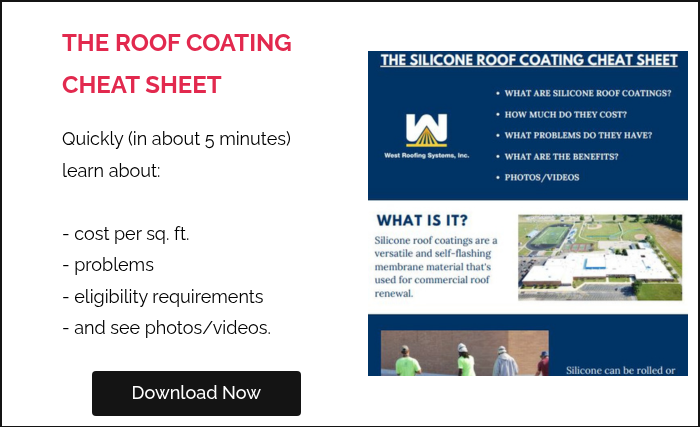Summary: Roof coating systems last for 10-20 years. This all depends on the thickness of the coating application. A 20-mil thickness will last 10 years. A 25-mil thickness will last 15 years. And a 30-mil thickness will last 20 years.
Do you have a commercial roof that needs to be restored? Perhaps your warranty ran out, but your roof is still in good condition.
Did you know you can add an elastomeric roof coating over your existing roof to extend its life?
Here’s a 25-second video showing how a roof coating system is installed:
So…how long do they last?
Elastomeric roof coatings can last between 10 and 20 years.
This all depends on the thickness of the coating applied to your roof.
- A 10-year warranty requires 20 mils of coating.
- A 20-year warranty requires 30 mils of coating.
Let’s begin…
Here’s a quick recap of what an elastomeric roof coating is

An elastomeric roof coating is a fluid-applied coating that’s sprayed or back-rolled directly onto an existing roof system.
These roofs are usually in good working order with minimal leaks, and their warranty is about to expire.
A building owner installs an elastomeric roof coating for a few reasons:
- it’s more cost-effective than a complete tear-off
- it’s considered maintenance (is not considered another roof layer)
- it adds a seamless, monolithic waterproof layer
- it’s white; therefore, it saves on energy costs compared to a dark-colored roof
But how long do elastomeric roof coatings last?
Elastomeric roof coatings will last 10-20 years, depending on the initial application thickness.
For a 10-year warranty, 20 mils of elastomeric roof coating will need to be applied.
For a 20-year warranty, 30 mils of elastomeric roof coating will need to be applied.
Elastomeric manufacturers (Henry, Progressive Materials, GAF, etc.) have performed extensive weather testing to determine the life of their products.
Can elastomeric roof coatings last longer than their warranty?
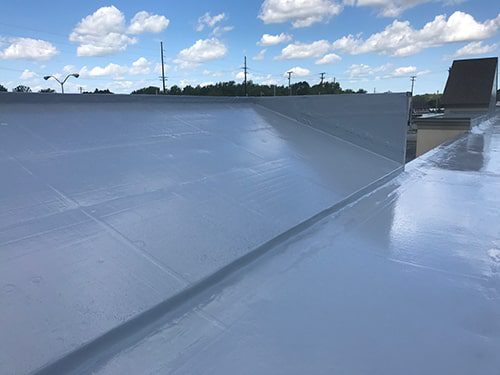
Yes, and most of them do. It isn’t extraordinary to see a 10-year-warrantied roof still in excellent condition after the warranty expires.
Brian Chavalia (40+ years of commercial roofing experience) has seen this personally. He inspected a roof 15 years after restoration and saw that the topcoat still had all the granules embedded.
If the granules are still embedded, all that coating is still underneath; otherwise, the granules would be gone.
An important fact to note is that elastomeric roof coatings will last longer with proper annual maintenance and inspection.
What maintenance is done to extend how long elastomeric roof coatings last?
Most roofing maintenance programs begin with a visual inspection and reporting. They are looking for early signs of significant damage. Damage can be caused by numerous events such as wind, rain, debris, or foot traffic.
Maintenance also includes special attention to areas that impact water travel, such as gutters, drains, and scuppers. A roofing contractor wants to ensure that when it rains, that water is moving the way it’s designed to off the roof.
NOTE: A maintenance contract is a great way to keep your facility in good shape while holding your contractor accountable for their work performance.
Has an elastomeric coating ever NOT lasted its intended lifetime?
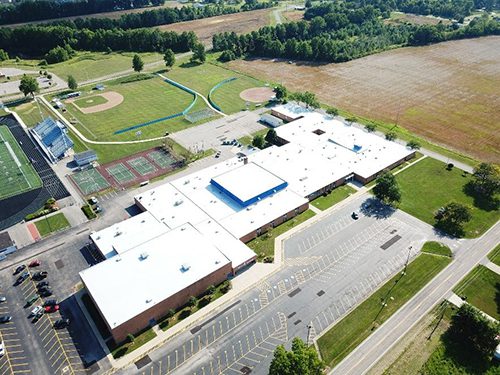
No. And if it didn’t last as long as intended, it would’ve been an applicator error. Some forms of applicator error would be:
1) Coating too thinly
For a 10-year warranty, 20 mils of coating needs to be applied. If less than 20 mils of coating are applied, then the product may not last the entire 10 years.
2) Coating too thick
If the coating is applied too thick (more than 20 mils for a 10-year warranty), then it’s simply a shame on the roofing contractor and great for the customer. This roof will perform great for more than 10 years.
3) Mixing improperly
The coatings used now are single components, meaning you just pop the drum open, give it a swirl and begin putting the product down. However, older coatings may have multiple components that must be mixed to perform correctly. If not, the product will not perform how it was designed to.
4) Applying before a rainstorm
This one depends on the elastomeric coating the roofing contractor applies. If it’s silicone, then it doesn’t matter. Silicone will still perform as it should if it rains slightly after installation. However, if the roofing contractor applies acrylic or urethane coating, rainfall slightly after installation will damage that coating. Rain can even wash your coating off the roof!
5) Poor substrate preparation
Preparation is King!
Just like painting the walls of your home, if your walls are full of dirt or dust, the paint will not adhere or perform as it should. A roofing contractor needs to clean and dry your existing substrate before application. If this isn’t done, the coating will not adhere properly and will not perform as it was meant to.
A rule of thumb is clean, dry, and sound.
The roof should be so clean that if you drop your sandwich, you should still want to eat it.
No joke!
A very clean roof is essential for proper adhesion and performance.
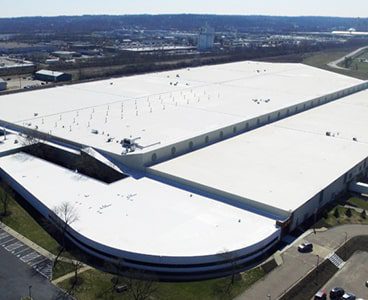
Does High Solids Silicone last longer than solvent-based silicone?
Newer to the industry than traditional solvent-based silicone is High Solids Silicone.
Without getting too technical into the differences between them, roofing contractors notice the high solids showing fewer signs of deterioration than the solvent-based silicone.
Some tendencies include an increased rate of wear and chalking.
Roofing contractors are using high solids more and more every day.
Why is solvent-based silicone still used?
On a roofing re-coat (say you did a silicone coating over your roof 10 years ago), a roofing contractor will most likely use a solvent-based coating. The reason is that solvent-based silicone grabs onto existing silicone better than high-solid silicone.
While high-solid silicone adheres to spray foam and rubber tremendously, it doesn’t grab onto existing silicone as great as solvent-based does.
First-time coating application = high-solids silicone, Re-coat over a high-solids silicone will most likely be high-solids.
Re-coats over a solvent-based silicone roof = solvent-based coating.
NOTE: Before installing coating over an entire roof, an adhesion test will be performed to ensure that the coating adheres properly.
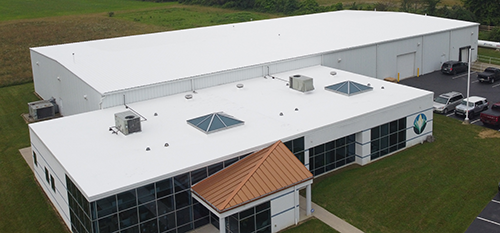
Summary of roof coatings and how long they last
Elastomeric roof coatings last 10-20 years.
Typical maintenance that’s done on elastomeric roofs are:
- visual inspections are meant to notice signs of significant damage
- to fix minor repairs
- to clean debris away from waterways so the water runs off the roof properly
Roofing contractors are beginning to use a “high solids” type of silicone for roofing purposes.
No studies prove that high-solid silicone is a better roofing product than solvent-based silicone.
However, high solids are showing no signs of the typical tendencies solvent-based silicones are showing, like extensive wear and chalkiness.
Want to learn more?
Here are some popular articles:
- How much do silicone roof coatings cost per square foot?
- What problems do roof coating systems have?
- What makes a roof eligible to receive a roof coating system?

